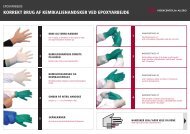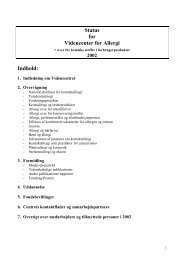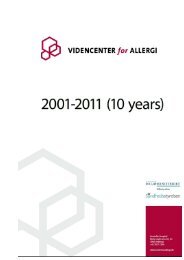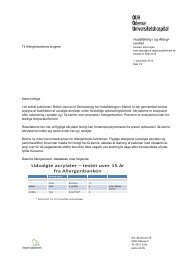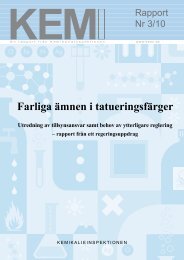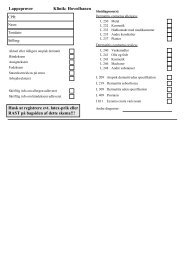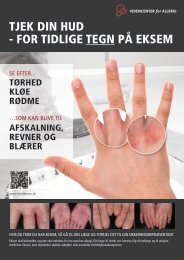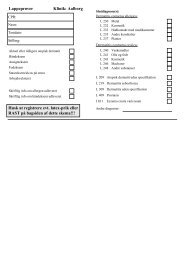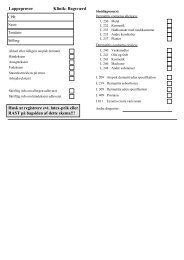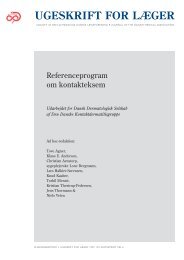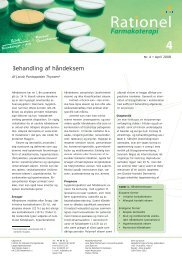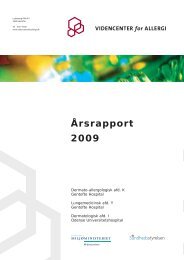Charlotte Devantier Jensen.pmd - Videncenter for Allergi
Charlotte Devantier Jensen.pmd - Videncenter for Allergi
Charlotte Devantier Jensen.pmd - Videncenter for Allergi
You also want an ePaper? Increase the reach of your titles
YUMPU automatically turns print PDFs into web optimized ePapers that Google loves.
1166 <strong>Charlotte</strong> <strong>Devantier</strong> <strong>Jensen</strong><br />
Table 5. The table shows the amount of soap used per application and<br />
the MDBGN exposure per unit test area <strong>for</strong> the test group and the<br />
controls.<br />
Average amount of soap Allergen-dose per<br />
used per application (g) application (µg/cm 2 )<br />
(mean ± SD) (range) (mean ± SD) (range)<br />
Test subjects 0.11 ± 0.08 [0.019,0.29] 2.2 ± 1.7 [0.37,5.81]<br />
Controls 0.10 ± 0.07 [0.018,0.28] 2.1 ± 1.5 [0.36,5.59]<br />
SD=standard deviation<br />
pared to MDBGN alone. Together with the difficulties of determining<br />
the actual allergen exposure, combination effects<br />
complicate the estimation of the inflammatory impact of rinseoff<br />
products.<br />
In addition to the use test, the subjects were patch tested<br />
with a dilution series of MDBGN (0.2%, 0.1%, 0.05%, 0.03%,<br />
0.02%, 0.01%, 0.005%, 0.003%, 0.002%, and 0.001% in eth./<br />
aq. (50:50)) to determine their patch test threshold values. An<br />
example of patch test reactions is seen in Fig. 6. 7 test subjects<br />
had a strong positive patch test reaction to the lowest patch<br />
test concentration of 0.001% and thus their patch test threshold<br />
values were below 0.001%. The test group was inhomogeneous<br />
with sensitivities to MDBGN ranging from very low<br />
patch test threshold values below 0.001% up to 0.2% MDBGN<br />
eth./aq. (Table 4). Most subjects with a positive use test response<br />
were highly sensitive to MDBGN-exposure with low<br />
patch test threshold values. 4 had a patch test threshold value<br />
below 0.001%; one a value of 0.003%, and 2 had somewhat<br />
higher threshold values of 0.05% and 0.2% MDBGN eth./aq.,<br />
respectively. These 2 used a larger amount of soap per application<br />
(0.14 and 0.19g) compared to the 5 other subjects who<br />
used an average of 0.044g of soap per application.<br />
Besides the content of allergenic ingredients, the use-pattern<br />
and type of cosmetic product are important factors in the<br />
evaluation of sensitization risk and in the determination of useconcentrations<br />
of cosmetic ingredients. For instance, application<br />
to a more penetrable and sensitive skin area, like the face,<br />
may increase the risk of sensitization or elicitation, as may<br />
frequent use of a product. Here we utilized liquid hand soap as<br />
the test product. Hand soap is applied to an often compromised<br />
Forum <strong>for</strong> Nord Derm Ven Vol. 10, 2005 – Suppl. 8<br />
skin barrier and this type of product is also commonly used<br />
several times a day, especially in occupational use-situations.<br />
There<strong>for</strong>e the allergen exposure from a liquid hand soap may<br />
be more potent than e.g. exposure from a body or hair shampoo.<br />
Facial rinsing creams are also rinse-off products with an<br />
increased risk of sensitization or elicitation, as the facial skin<br />
is delicate.<br />
A few cases of allergic contact dermatitis from rinse-off products<br />
have been described. However, often it has not been possible<br />
to establish whether the product was also the primary<br />
sensitizer. Zachariae et al 44 recently presented a number of<br />
cases of allergic contact dermatitis from cosmetic products<br />
preserved with MDBGN; in some of the cases rinse-off products<br />
containing MDBGN were involved. In 4 cases, liquid hand<br />
soaps containing MDBGN were found among the patient’s<br />
cosmetic products and in 2 of these cases the soaps were believed<br />
to have played a part in sensitization. In another case, a<br />
facial cleansing cream had elicited hand and facial dermatitis<br />
in a pre-sensitized patient. Fernandez et al 60 presented a case<br />
of elicitation of allergic contact dermatitis from a facial cleansing<br />
cream as well. In a recent communication by Diba 61 , 3<br />
cases of allergic contact dermatitis from occupational uses of<br />
hand soaps containing MDBGN were described. Whether the<br />
soaps were responsible <strong>for</strong> the sensitization of the patients was<br />
not discussed in the article. Tosti et al 59 reported 4 cases of<br />
allergic contact dermatitis from MDBGN with rinse-off products<br />
as the only apparent sources of exposure to the allergen.<br />
Two patients were using a soap containing MDBGN, one was<br />
using a facial cleansing cream and one was using a foaming<br />
soap. The dermatitis cleared once the use of these products<br />
was discontinued. In a recent case, a man developed allergic<br />
contact dermatitis in the genital area and MDBGN in a hand<br />
soap was found to be the causative agent 45 . However, the man<br />
described vigorous use of the soap to cleanse his skin after<br />
intercourse, implying that irritation of the sensitive genital skin<br />
was an important contributing factor.<br />
Rinse-off exposure studies with MCI/MI have been per<strong>for</strong>med.<br />
In one use test, 4/4 pre-sensitized subjects developed<br />
reactions to a shampoo containing 25 ppm (0.0025%) MCI/<br />
MI 34 . In a double blind, randomized parallel study in 27 MCI/<br />
MI-allergic subjects, no statistically significant difference was<br />
found between reactions to a shampoo preserved with 15 ppm<br />
Fig. 7. Illustration of the study<br />
design of Trial II.




